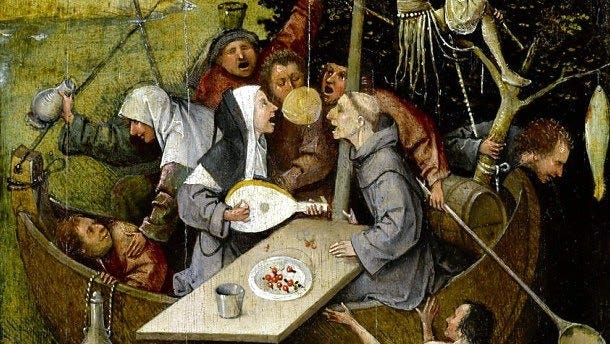Dear Friends,
Missed last week’s post? This post continues a conversation about neurodiversity started here. The next part of this series resumes after the discussion of the Image Bearers resource below under the header Supporting Neurodivergent Children & Youth in Parish Community.
It seems fitting that the second week of this falls amidst some of the Gospel’s healing stories. In this Sunday’s lectionary we have not only the the story of the Syrophoenician woman and her daughter (which is also fraught for reasons unrelated to the healing aspect) and the deaf man in Decapolis. Non-normative bodies and minds are the canvas for Jesus’s signs and wonders.
Why is that, anyway?
I want to believe that this was about more than proof of power, that this wasn’t just Elijah and the Prophets of Baal reprised – a game of my God is more powerful than yours. And there are days when I’m painfully aware of how much that declaration of “Ephphatha” – “Be Opened” – or its various equivalents could change my life. Instead, I’m writing this newsletter while operating with the thinnest of functioning margins because I had my first driving lesson last Thursday and I am a vibrating ball of anxiety and tears and inability to focus.
Unfortunately, there’s not a lot of room for the grace of rest in my life in the coming weeks. And, to return to the point, I don’t want to overlay a contemporary model of disability pride, inclusion, and the like onto scripture. I’ve read Foucault’s History of Madness (the 600 page monstrosity, not Madness and Civilization). I know about the function of the city gates, the ship of fools, the many iterations of the asylum. To cure in the context of first century, to re-enable could certainly be called grace – even if I am politically opposed to frameworks of cure.
In case hearing these healing stories year in and year out or encountering disability in your own life haven’t revealed this to you, disability is complicated.
Inclusion, accessibility, and accommodations are complicated, too.
Representation, Inclusion, & Disruption
One of my favorite things about the progressive Christian book market today is just how inclusive many illustrators are of the different ways we all show up in the world. Those of you who have been around for a while have found me delighting in some of the subtle details in Glenys Nellist’s “Wherever You Are,” for example, or spotting a child who uses a wheelchair repeating in the pages of “What Is God Like?” by Rachel Held Evans and Matthew Paul Turner. And, because the internet is the way that it is, I often unearth unexpected things in my search for resources.
Among these peculiar discoveries of late is Image Bearer by Ellie Samazaro. There’s certainly a lot that’s inscrutable about the overall theology behind this text, but as a resource on diversity, inclusion, and seeing the image of God in all people, it’s doing a great job. In particular, I love their “Meet the Image Bearers” page, which connects us to profiles of the children who are illustrated in the book, sharing some of their real life stories. I’m also really impressed by some of their blog resources on talking about disability with kids, which uses inclusive language, links to other picture books and social media accounts, and encourages children to see the similarities between typical, non-disabled children and their disabled peers.
Turning for a moment to another one of the healing narratives, I really enjoyed their post on “4 Principles of Accessibility and the Church found in Mark 2,” which is the story of the paralyzed man whose friends lower him down through a hole in the roof to reach Jesus. It’s a post that really emphasizes the ways in which we are called to come alongside each other in our struggles while also naming the (sometimes negatively) disruptive potential of inclusion. I could keep talking about this website, but it certainly was a lucky find!
Yes, cutting a hole into the roof because it’s the only way to get a paralyzed person into the building is disruptive. Building a ramp to the altar may be disruptive – to the architecture of the space, to what we think an altar space should look like, but also to our image of who is welcome and expected to lead. The person who has tics during worship may be literally disruptive. Children are often pointed to as disruptive. (I am notoriously disruptive because of the ways I center children in my ministry.)
So, let’s return to the model question that kicked this Back To School series off:
We want to do more to support neurodiverse children and youth. What are some good resources to start with?
Supporting Neurodivergent Children & Youth In Parish Community
Where do we start? This is the question I notoriously refuse to answer directly because I want people to be specific. I want to know more about who you you are trying to include and how disruptive you’re willing to be.
Still, we do actually need to begin somewhere, as frustrating as a lack of specificity can be – so welcome to my toolbox.
At my parish, you can find a bin near the entrance to the nave that reads, “Need Support?”
The goal of my basic resource bin (many of the items included here are also found in our Church School classrooms) is to hit a number of different sensory needs and systems, as well as offering a number of items that may already be familiar to the children. My go to items include:
Ear Defenders: I don’t go anywhere without my ear defenders, and I keep two pairs in the basket in case the organ and microphones are too loud.
Tangles and Stress Balls: I chose a style of stress ball that contains a sort of doughy interior - the ones that are liquid on the inside make me nervous! Tangles are another one of my go-to items; they’re ideal for introducing fidget tools because they don’t really “do” much but they do keep fidgety hands busy.
Liquid Timers: For folks who regulate via visual stimuli, liquid timers can be soothing and centering. They offer something to focus on, often have a very regular pattern, and come in many different styles.
Tactile Mazes: I invested in a set of the hand2mind Mindful Mazes but this is another item that comes in many forms – and as a bonus, these “kid friendly” styles can be a great introduction to traditional mindful prayer practices like finger labyrinths.
Deep Pressure Bands: These are something of a dark horse item, but they’re a genius option for people who may need some proprioceptive feedback. These bands can go around most of the body while sitting to help you know where your body is in space or can be used to provide some calming bodily input before moving into other activities.
Now obviously these are tools that are only going to meet sensory needs, even if I’ve curated the tools to touch on a lot of different sensory systems and preferences. They might also help with anxiety or support attention. But there’s a lot missing if we’re trying to talk about neurodivergence writ large.
So, let’s talk about some other pieces of the picture (shocker - we’re not going to get through this “Back To School with Bird” series this week):
Did you know there are some fonts that are easier for people with dyslexia to read and particular formatting options (like all caps) that can make it much harder? This newsletter/Substack in general don’t offer great options for this, but it’s easy to use san serif fonts, to increase letter spacing (kerning), avoid italics – bold is better – or to use cream or pale pastel papers for hardcopy materials like bulletins and worksheets.
Now let’s talk about neurodivergence and seating. I love the look of pews as much as the next person, but if I’m not standing off to the side or crouching next to a child, you’ll often find me sitting at a wall or aisle where I can lean against something. There are a number of reasons for this, but many autistic people, as well as those with ADHD can benefit from additional physical support because of postural instability linked to poor proprioception.
Chairs with arms can be helpful, as are alternative seating options that provide boundaries or stability (in contrast to things like wobble cushions or stools that increase that instability), while putting some kickbands on classroom chairs can allows for more “fidgety” input while sitting. Similarly, people with Down syndrome may have low muscle tone and can also benefit from more supportive seating.
What should be coming into focus here is that, if you are earnest about the work of including neurodivergent people in your church community, then you need to understand all the working parts. Our cognitive differences don’t end with how we use language, with sensitivity to sound, difficulty with eye contact, or our ability to sustain attention. Inclusion, even when you think the framework is exclusively cognitive, is actually a full body undertaking.
Resource Roundup
What else is going on in the great big tent of the church world?
Some of you may have arrived here via the And Also With You podcast (and if you’re new here, welcome to this very exclusive club!) with the Revs. Laura & Lizzie, but for those of you who aren’t regular listeners yet, I’m featured on this week’s episode on the theme, “How do I bring faith home?” It was so much fun chatting with Laura and Lizzie about both the ways faith was transmitted to and shaped in me as a child and how we can engage that process in open and welcoming ways at home
.
I may not be Methodist, but I’m excited for this soon-to-be released book by Robert Lee and Melissa Collier Gepford - You Are Mine and I Am Yours: A Wesleyan Prayer for Kids. If you’re not familiar with the Wesley Covenant Prayer in its original old-fashioned language, it is used each year to reaffirm covenant with God and begins, “I am no longer my own, but thine. Put me to what thou wilt, rank me with whom thou wilt.” It’s a really beautiful prayer of discipleship and will undoubtedly be a useful and inviting text beyond Wesleyan traditions
Over with the Presbyterians, there are some new Read Play Wonder story guides, including one for Elizabeth Caldwell and Theodore Hierbert’s book, God’s Big Plan. Caldwell is one of those names that, when I see if on a children’s formation resource, I know it’s going to be good!
Clergy friends! The Essence of Ministry: A Devotional for Clergy by Clergy Embracing Children’s Spirituality is a great new devotional text developed as part of a Lily Grant project and the Center for Lifelong Learning at VTS. Co-editor Donna Sweeting is one of my colleagues from Godly Play’s equity work space, with Missiouri McPhee and Allison Liles, a familiar name from Grow Christians, and this team has got additional devotionals in the works.
That’s all for now! I’m leading a Godly Play Core training later this week, so I ask your prayers for the community that will gather for that work (and for my energy through this lengthy and life-giving process - we’ll spend an intense 2.5 days together).
Peace,
Bird







